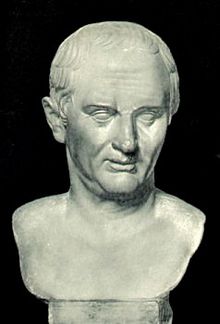Cicero is always a helpful ally in any argument. And in chapter 2 of her book, Mitchell grounds her argument in the standard techniques of ancient rhetoricians like Cicero. The primary text in question is 1 Cor 5:9-11, which Mitchell identifies as Paul’s first act of “self-exegesis.” In these verses, Paul writes, “I wrote you in my letter not to associate with sexually immoral people. In no way did I mean the immoral people of this world, or the greedy and swindlers and idolaters, since you would then have to go out of the world. But now I am writing to you not to associate with anyone who calls himself a Christian who is sexually immoral…” Whereas some of the Corinthians were misreading Paul by literally globalizing his instructions, Paul here defends one particular interpretation of his previous words on account of 1) the exact wording of the text, and 2) the logical meaning and practical result of the text.
Mitchell argues that what Paul is doing here was common in ancient rhetoric. The ancients realized that texts could be interpreted different ways, which led to the need for Mitchell’s “agonistic paradigm.” As her chief example, Mitchell analyzes Cicero’s De  inventione, which offered a list of criteria and rhetorical strategies by which to argue if a text should be understood literally or figuratively. This was not an invention of Cicero but rather a traditional set of commonplaces known throughout the ancient world. For instance, the interpreter might appeal to everyday speech, literary context, the character of the author, or the consequences of the opponent’s reading to support either a literal or a figurative reading. And this is precisely what Paul is doing in 1 Cor 5:9-11. As it would be impossible to comply with the misunderstood command (utter separation from the entire world), this could not have been what Paul meant.
inventione, which offered a list of criteria and rhetorical strategies by which to argue if a text should be understood literally or figuratively. This was not an invention of Cicero but rather a traditional set of commonplaces known throughout the ancient world. For instance, the interpreter might appeal to everyday speech, literary context, the character of the author, or the consequences of the opponent’s reading to support either a literal or a figurative reading. And this is precisely what Paul is doing in 1 Cor 5:9-11. As it would be impossible to comply with the misunderstood command (utter separation from the entire world), this could not have been what Paul meant.
Here’s the upshot: the ancients did not universally practice literal or figurative interpretation. Rather, they drew from a common set of rhetorical criteria to argue for or against their case. As Mitchell puts it, “The agonistic paradigm is inherently dualistic and combative” (26). And, to summarize, these rhetorical strategies “are not linguistic or hermeneutical theories that represent an absolute commitment or a systematic philosophical engagement with the relationship between text and meaning; they are fragments of linguistic theories used to buttress a particular interpretation on well-known terms” (27). This shatters the myth of the absolute wall between the schools of Alexandria and Antioch and is equally challenging to today’s Bible teachers (and Seminary professors!) dead-set against allegorical interpretation (especially when it comes to eschatological imagery…).
Of course, in evaluating this chapter we find ourselves back in the well-known place of wondering just how thorough Paul’s classical education would have been. I suspect he was indeed trained in the best of Greco-Roman rhetoric, but the extent to which he consciously drew on that remains up for debate. Did he read Cicero? Probably. But even if he did not, I suspect certain rhetorical conventions were familiar enough in the ancient world that we shouldn’t be surprised to see them in his writings.

